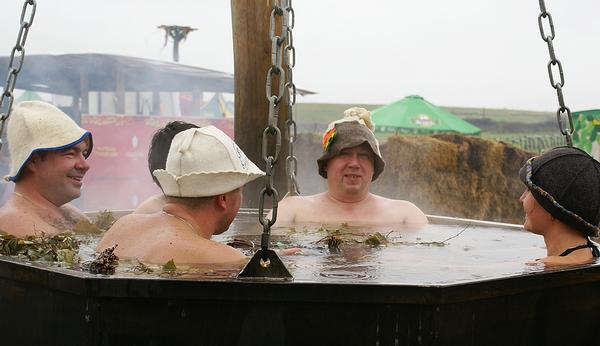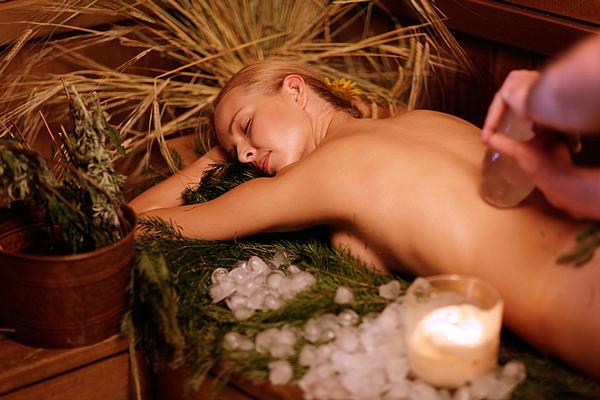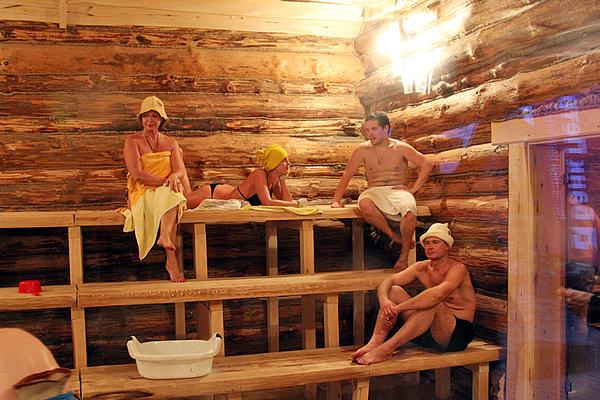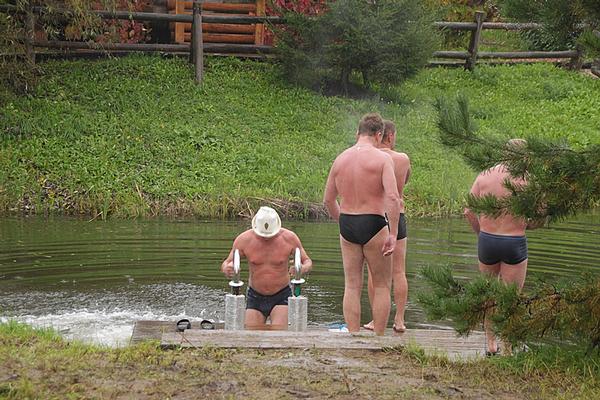 SELECTED
ISSUE
SELECTED
ISSUE
|
|
Leisure Management - Russia

Everyone’s talking about

|
|
| Russia
|

Jak Phillips gives an overview of the Russian spa industry and those working in the sector share their insights on the opportunities and challenges for businesses
|


Banya, the famous sauna culture in Russia that’s more than 1,000 years old, is ripe for development ©RUSSIAN BANYA CHAMPIONSHIPS


There are an estimated 1,000 spas in Russia, plus 2,000 traditional health resorts and sanatoriums ©FOX LODGE HTTP://ENG.FOXLODGE.RU;©RUSSIAN BANYA


There are an estimated 1,000 spas in Russia, plus 2,000 traditional health resorts and sanatoriums ©FOX LODGE HTTP://ENG.FOXLODGE.RU;©RUSSIAN BANYA


There are an estimated 1,000 spas in Russia, plus 2,000 traditional health resorts and sanatoriums ©FOX LODGE HTTP://ENG.FOXLODGE.RU;©RUSSIAN BANYA


There are an estimated 1,000 spas in Russia, plus 2,000 traditional health resorts and sanatoriums ©FOX LODGE HTTP://ENG.FOXLODGE.RU;©RUSSIAN BANYA
|
|
|
As the world’s largest country by area, Russia boasts a diverse landscape and with it comes copious natural resources, ranging from thermal water in the highlands through to abundant muds, salt, herbs and gases suitable for holistic treatments. As with the other BRIC economies, Russia’s middle class is growing rapidly – jumping from 30 to 60 per cent of the total population from 2001-2010, according to data from the Russian Longitudinal Monitoring Survey. This burgeoning demographic makes up a significant proportion of customers for the spa market which is dominated by domestic tourism. In addition to growing disposable incomes, Russia’s 143.5 million citizens have considerable time to spend at leisure, with state employees receiving 24 days vacation each year, plus 10 public holidays. International tourism is also growing, with inbound visitor numbers jumping 13.4 per cent (United Nations World Tourism Organisation) to 25.7 million in 2012, although the country still suffers from an image problem. Despite this, major events like this year’s Winter Olympics in Sochi and the 2018 football World Cup are expected to boost interest. One of the main weaknesses of the Russian spa industry is its lack of infrastructure and organisation. The last major analysis of the sector – Overview of the Current State of the Russian Spa Industry – by consultant Nina Tsymbal (see p72) was conducted in 2008 and statistics are hard to come by. The Spa and Wellness International Council, a Russian spa body (see p70), estimates that there are 1,500 spas in the country, with only one third corresponding to international standards. In addition, there are around 2,000 traditional medical-focused health resorts, or sanatoriums, which are often located on mineral springs or the coastline. Today, a resurgence of these dilapidated sanatoriums is underway and international players are circling to develop them into spa hotels, particularly in the Sochi area. Banya, the famous sauna culture in Russia dating back 1,000 years, is also ripe for development (see SB14/2 p50). Public bathhouses like Sanduny in Moscow are located across the country while modern facilities such as Fox Lodge – a lakeside retreat north of the capital – are including them as part of a conventional spa offer. What might scupper the growth of the spa industry in Russia, however, is economic instability and, from an overseas tourism and investment perspective, international relations following the annexation of Crimea. If the oft-discussed visa agreement with the EU comes into play, this could offer a solution to these barriers but this is contingent on whether the currently frayed diplomatic relations can ever become close-knit. Here, we ask operators and consultants in Russia about the state of the country’s spa industry, the cultural and economic factors affecting it and what trends, opportunities and obstacles they’re seeing. Special thanks to Galiya Abaydulina, the brand manager for Thalion in Russia, for her help with the research of this feature. Details: www.thalion.com; +7 495 792 58 95
|
|
 |

Ekaterina Sharkova
Assistant Manager
Mandara Spa, Lotte Hotel Moscow
 |
|
There’s much potential to increase spend from clients, as the arrival of big international firms in Russia has driven up wages, leading to more disposable income for the middle classes. The women here are highly competitive when it comes to looking good and are happy to pay for it. We’re also seeing a noticeable shift in the media towards health and wellness – perhaps reflecting the interest of readers – with a lot more articles focusing on fitness, diet and beauty.
In terms of weaknesses of the spa industry, infrastructure still leaves a lot to be desired and there’s a lack of qualified spa managers, although the work of the Spa and Wellness International Council is doing a lot to improve this (see p70). At the moment, the bulk of investment comes from wealthy Russians, who want to own a beautiful business, but lack the nous to make this a reality. As a result, we’re seeing a lot more tie-ups between Russian investors and firms from the EU, something I hope will help to hasten the improvement of standards. However, overseas investment regulations in Russia are still quite strict, so it’s essential that international companies which are looking to move into the market have strong Russian partners. As you might expect, we’re seeing many more spa consultants popping up to bridge the gap.
Hospitality developments in Sochi, sparked by the Winter Olympics, have attracted several international players and again, this will hopefully drive up standards. There’s also the 2018 World Cup on the horizon and I think there’s a real gap in the market for affordable four-star hotels, whose numbers are currently dwarfed by exorbitant five-star establishments. Whether a lot of this will be successful hinges largely on international relations. It’s becoming easier to get a Russian [tourist] visa, but it still requires a lot of time and money, so agreements between countries will be key to boosting visa accessibility and getting more people coming to visit.
A key member of the Mandara Spa team at Lotte Hotel Moscow, Sharkova has contributed to the success of the facility which has won numerous awards since opening in 2011.
Details: www.mandaraspa.com
Overseas investment regulations in Russia are still quite strict, so it’s essential that international companies which are looking to move into the market have strong Russian partners
|
|
 |

Elena Bogacheva
Founder and president,
Spa and Wellness International Council (SWIC)
 |
|
We’re seeing a generational shift in Russia’s spa clientele, which could yet become one of its biggest strengths. The baby boomers who used to visit spas for self-indulgence, are more wellness-focused, motivated by the need of active longevity. Meanwhile, spas are becoming an essential component of a healthy lifestyle for new generations of clients, who’ve left university and are now earning competitive salaries.
There’s also an interesting trend towards spas for children. It’s a concept I first tried out in 2002 and I’ve since advised on an increasing number of projects. In Kazan, an existing kids spa is now expanding to become a wellness centre offering hydrotherapy, halotherapy and kinesiotherapy.
New spas in Russia can easily compete with the best facilities in western Europe and the Americas with their picturesque locations, innovation, medical training, menus and designs. However, the service skills of our massage and beauty therapists leave a lot to be desired. Aside from better training, we have to change the mentality of staff, to shift from the supervisory attitude of former physicians and nurses to a sincere willingness to serve and please.
There have generally been very strict regulations for spa services in Russia which has made it difficult for the industry to expand with confidence and attract investment. Because health resorts/sanatoriums have been intrinsic to the industry, all facilities needed to obtain a medical licence to operate and were regulated by the healthcare system – even if they were only offering manicures or pedicures. But in January, two National Standards for Spas and new codes were adopted so non-medical spas no longer need to operate under Health Ministry standards or obtain a medical licence. This was a major achievement for SWIC [which led the negotiations] and the spa industry.
Old health resorts in the south are hot spots for development. They have a wide range of scientifically-proven healing methods, skilled medical staff and are often based around mineral sources. The resort town Kislovodsk, with its unique springs, is on its way to becoming the Russian Carlsbad. Likewise the city of Sochi, with its therapeutic ‘macesta’ muds now has infrastructure from the Olympics and has huge potential to become a hub for international wellness tourism.
A pioneer of the Russian spa industry, Bogacheva founded SWIC in 2010 to help raise standards and drive forward development in the sector.
Details: www.1swic.ru
|
|
 |

Julia Johansson
CEO
Spa Orient Express
 |
|
One of the best things about Russian spa specialists is that they’re highly-trained [thanks to the health sanatorium tradition]. They must go through two to three years of medical training and this means they’re able to solve clients’ body problems by carrying out detailed diagnoses and then recommending holistic solutions. Many of them also travel either to Europe, Japan or Thailand to learn their trade and this means they arrive with a broad range of influences and ideas.
As a city spa, this enables us to diversify our offering. It’s important that we can cater for all of our clients’ needs while remaining innovative, so it’s vital that our staff are creative and able to form long-term relationships with customers.
The fact that Russian spa specialists are very creative, multi-disciplined and each bring their own personal approach can also be a downside though. Their urge to individualise treatments means they’re nearly impossible to train to a set level of consistency and they frequently break protocol – although this is mainly because they want to deliver as much as they can and satisfy every need of their client.
From a product point of view, Russians expect instant results and like to use different products, so some international hotel spas struggle because of their single-brand tie-ups. Rents are very high in Moscow and retail makes up around 25-28 per cent of spa income, but one of the big threats is that clients are starting to buy discounted products from retail outlets. Spas are trying to counter that by pursuing city-exclusive tie-ups for sought-after products, but this can also be problematic. The economy isn’t currently as strong as it has been – the rouble crashed 11 per cent in the aftermath of the Ukraine incident – and this makes it very expensive to import products from overseas, especially when you factor in registration and other administrative prices.
Johansson has been CEO of central Moscow’s Spa Orient Express for almost 15 years. The facility also houses one of Madonna’s Hard Candy Fitness gyms.
Details: www.orientexpress-spa.ru
The economy isn’t currently as strong as it has been – the rouble crashed 11 per cent in the aftermath of the Ukraine incident – and this makes it very expensive to import products from overseas
|
|
 |

Elena Silantyeva
Professor in rehab and obstetrics/paediatrics
Lapino Medispa
 |
|
Russia has a steadfast philosophy that medicine and spa therapies are intrinsically linked and a lot of this can be traced back to the late 1940s when the Soviet Union looked to kick-start technical innovation. They needed workers to be fit and healthy so lots of government money went into wellness research and workers were sent to sanatoriums for a mix of relaxation and medical procedures to maintain their health and ensure they were fit for purpose. This sowed the seed for what has now become the trend of medi-spas.
Our hospital (in Moscow’s exclusive Rublevka district) offers treatment programmes to pregnant women and more recently the over 50s, combining spa and medical procedures. Pregnant women are by far our biggest customers because they want to stay fit, beautiful and minimise the impact of pregnancy on their bodies, while ensuring a safe birth. We’ve started to attract a lot of clients from the UK, Germany and the US – particularly those with prior infertility problems – and this seems to be a growing market.
On the medical side, we provide birthing, cosmetic surgery, cardiac analysis and dietary programmes. In terms of wellness, spa therapies are used to supplement the benefits of medicine. For example, we’ve found that the ability of postnatal electrotherapy to relieve muscle and joint pain can be doubled by following the procedure with thalassotherapy. Many spa therapies have a medical benefit and many medical procedures are best performed in a natural spa setting, so it seems like an ideal fit.
One of the reasons we expanded to cater for over 50s was because health levels in Russia are low. There’s little access to preventative medicine and many are not well enough to undergo conventional treatments, so there is a need to combine spa with medicine.
Silantyeva has carved a niche in the medi-spa sector by combining her medical background with spa therapies to specialise in wellness offerings around birthing and anti-ageing.
Details: www.mcclinics.com
|
|
 |

Nina Tsymbal
Spa consultant
Russia
 |
|
In Russia, as in many other parts of the world, the interest in disease prevention is steadily growing and this presents one of the biggest opportunities in our sector. This July, I completed a report – Overview of Wellness Tourism in Russia – based on data from the Russian Union of Travel Industry to look at this part of the industry, its trends and measures for improvement.
The term ‘curative & wellness tourism’ is the most appropriate in Russia due to its health resorts (historically called sanatoriums) based around natural, therapeutic resources such as mineral water and mud. Typically, such resort holidays offer an all-inclusive pre-paid treatment package consisting of a medical check-up and at least three to four daily treatments.
There are around 2,000 traditional health resorts in Russia. And fuelled by mostly Russian investment, there are a growing number of hotels – the total was over 9,000 last year. Many of the new high-end hotels are managed by international operators and offer modern spa facilities.
Overall, wellness tourism is on an upward trajectory. Tour operator ALEAN reports that wellness tours accounted for 30 per cent of business last year, compared to only 10 per cent in 2007. Inbound tourists play a minute part in this, with figures from the Moscow Medical and Health Tourism Congress showing that less than 1 per cent of foreign visitors stayed at sanatoriums in 2012. In comparison, in 2013, almost 33 million Russians travelled inside the country and 8 million (24 per cent) of them went to sanatoriums.
One of the greatest trends is a shift in the demographic of wellness tourists. In the past, the majority were aged 45-70, but today they’re mostly 30-50 – although more than 50 per cent of customers are still women over 45 years old.
Older wellness tourists still prefer traditional sanatoriums. They choose the destination according to the curative resources and therapeutic specialisations that match their own health concerns. In contrast, younger wellness tourists opt for beach holidays and spa centres. Most aren’t familiar with traditional domestic sanatoriums, but they travel abroad and are accustomed to western service standards and look for these back home.
In fact, there’s a growing preference for five-star facilities across the board as even those staying at sanatoriums now expect comfortable accommodation.
Modernisation of resort infrastructure is a key area to focus on when it comes to the future of wellness tourism in Russia. Other areas of consideration moving forward should include alignment with social tourism where funds are allocated for social needs; improvements in transport infrastructure; and legislation to preserve the natural resources as the sector grows.
Based in St Petersburg, Tsymbal has been a spa consultant in Russia for 14 years.
Details: ntsymb@peterlink.ru
Alignment with social tourism, improvements in transport infrastructure and the preservation of natural resources all need consideration as the sector grows
|
|
Jak Phillips is the head of news at Leisure Media
Email: jakphillips@leisuremedia.com
Tel: +44 1462 471938
|
|
 |
| Originally published in Spa Business 2014 issue 4
|
|
 |
|